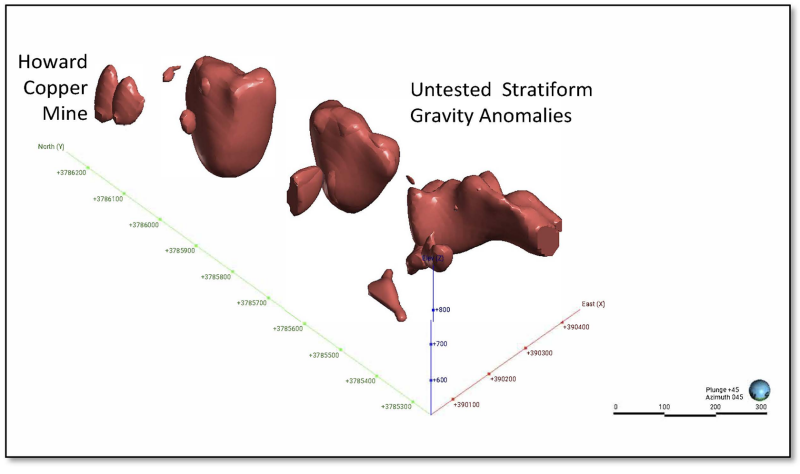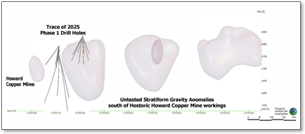King Global Ventures to Drill-Test Significant Gravity Anomalies South of Historic Howard Copper Workings
thenewswire.com
Vancouver, British Columbia – TheNewswire – August 26, 2025 – King Global Ventures Ltd. (TSXV: KING) (FSE: 5LM1) (“King Global” or the “Company”) is pleased to announce exploration plans to drill-test three significant gravity anomalies recently identified at its 100%-optioned Howard Copper Project in central Arizona. These anomalies which identified in a post-drilling geophysical survey, represent well defined targets located south of the historic Howard Mine workings, directly along the vector of improving mineralization identified in the most recent drilling.
Phase I Drilling: Best Results South of the Historic Mine
The Company’s 2025 Phase I diamond drill program (20 holes, 8,000 feet) confirmed the presence of two distinct volcanogenic massive sulphide (VMS) horizons within the Spud Mountain Formation. The strongest copper-gold-zinc-silver intercepts occurred in the southernmost drill holes (e.g., HC-25-015, HC-25-020), beyond the limits of the historic Howard Mine. These results confirmed that mineralization improves to the south and remains open at depth and along strike (For complete Phase I drill results, please refer to the Company’s news release dated August 13, 2025, available under King Global’s profile on SEDAR+).
Gravity Survey: Untested Anomalies Along Trend
Following the Phase I drill program, ALS Geoanalytics completed a gravity inversion analysis that revealed three discrete, stratigraphically conformable gravity anomalies trending NNW–SSE and aligned with the regional volcanic stratigraphy.
Key findings include:
- Three untested gravity anomalies lying south of the historic workings and beyond the Phase I drill fences.
- Alignment with favorable volcanic-sedimentary horizons, suggesting potential stacked VMS lenses.
- Coincidence with magnetic features in the southern anomaly, reinforcing the interpretation of preserved sulphide bodies.
These gravity anomalies collectively represent a modeled subsurface density anomaly. While conceptual in nature, their size, geometry, and alignment with the mineralized vector highlight a prospective corridor for follow-up drilling.
Expanded Exploration: New Claims and Surveys
In parallel with drilling, King Global will also undertake a series of ground-based programs to refine targeting and extend the known anomalies:
- Ground EM survey to detect conductive sulphide bodies associated with the anomalies.
- Soil geochemical sampling to define surface geochemical halos.
- Follow-up gravity survey to extend and track the southernmost anomaly onto newly acquired claims south of the current project area.
Phase II Drill Program: Targeting Gravity Anomalies
Building on the Phase I, King Global will immediately advance to Phase II drilling, designed specifically to test all three gravity anomalies south of the historic workings.
- The proposed program will comprise approximately 9 holes totaling 7,000 to 9,000 feet.
- Objective: Directly test the southern gravity anomalies, following the trend of improving mineralization encountered in Phase I.
- Exploration Strategy: Confirm the presence of sulphide-rich horizons within these anomalies and expand the mineralized footprint southward.
Rob Dzisiak, CEO of King Global Ventures, commented:
“The Phase I program proved that mineralization strengthens south of the historic Howard Mine. The identification of three large, untested gravity anomalies further along this vector gives us a clear next step. Phase II will directly target these anomalies, with the potential to expand the known mineralized system.”
Qualified Person and NI 43-101 Disclosure
Andrew Lee Smith, P.Geo., who is the Senior Geologist for King’s Black Canyon Project and a Qualified Person under NI 43-101, has reviewed and approved the technical content of this release.
Cautionary Note: The potential quantity and grade of the gravity anomalies are conceptual in nature. There has been insufficient exploration to define a mineral resource, and it is uncertain if further exploration will result in the discovery of a mineral resource.
Gravity inversion data showing then voluminous gravity anomalies, south the smaller gravity anomaly in the in the area of the Howard Copper mine workings.
Howard

Click Image To View Full Size

These gravity anomalies collectively represent a modeled subsurface volume of approximately 9 million cubic metres. This estimate is based on geophysical inversion modeling and does not imply the presence of economic mineralization.
About King Global Ventures:
Black Canyon Property in Arizona
King Global Ventures is focused on the exploration of precious and base metals in North America. The Black Canyon Project in Yavapai County Arizona is comprised of 213 contiguous concessions covering a total area of 3,780 ac, including 15 former operating mines including the past producing Howard Copper Mine. And is situated 100 km (62 miles) north of Phoenix Arizona. The Black Canyon Project represents an early-stage exploration opportunity targeting copper-gold-silver-zinc, Volcanogenic Massive Sulphide (“VMS”) mineralization. The geology of Yavapai County, Arizona is notable due to the presence of a variety of base and precious metal deposit types. The region has a significant history of exploration, discovery and mining operations, including base metals from mining operations like Bagdad, Jerome and Cleopatra. The property is on trend and is approximately 13 km (8 miles) N.W. of Arizona Metals .
The Howard Copper Mine Property is located on 78 acres of patented land approximately 100 km (64 miles) north of Phoenix AZ. Discovered in the early 1920’s, small scale production and development focused on high-grade copper. Historical reports state that the main shaft was sunk to the 900-foot level, but that no ore was mined below the 500-foot level.
The Mikwam Property
The Mikwam Gold Property is located in Noseworthy Township within the Abitibi Greenstone Belt of the Superior Province, northeastern Ontario. It lies along the Casa Berardi Deformation Zone that hosts Detour Gold’s Burntbush Property. The Mikwam deposit is hosted within Timiskaming-aged polymictic conglomerate and greywacke units and contains disseminated and vein-hosted gold mineralization associated with quartz-carbonate veins and pyrite mineralization.
In 2016, a NI 43-101 technical report prepared for Galena International Resources Ltd. by Caracle Creek International Consulting Inc., dated December 8, 2016, disclosed a historical inferred mineral resource of 1,810,000 tonnes grading 2.34 g/t gold, containing 136,000 ounces of gold at a cut-off grade of 1.00 g/t Au. This estimate (announced in December 12, 2016 press release) is historical in nature, was not prepared for King Global Ventures Inc., and should not be considered current. A Qualified Person has not done sufficient work to classify the historical estimate as current mineral resources and the issuer is not treating the historical estimate as current mineral resources.
Additional information about King Global Ventures can be viewed at the Company's website at www.kingglobal.gold or at www.sedarplus.ca.
On behalf of King Global Ventures
Robert Dzisiak
Chief Executive Officer
204-955-4803
ir@kingcse.com
The technical contents of this news release were approved by Andrew Lee Smith, Bsc., P.Geo, ICD.D, a qualified person as defined by National Instrument 43-101.
Neither the CSE Exchange nor its Regulation Services Provider (as that term is defined in the policies of the CSE Exchange) accepts responsibility for the adequacy or accuracy of this release.
Cautionary Statement Regarding Forward-Looking Information
Certain information in this news release may contain forward-looking statements that involve substantial known and unknown risks and uncertainties. These forward-looking statements are subject to numerous risks and uncertainties, certain of which are beyond the control of the Company, including but not limited to, the uncertainty of the financing, the impact of general economic conditions, industry conditions, dependence upon regulatory approvals. Readers are cautioned that the assumptions used in preparing such information, although considered reasonable at the time of preparation, may prove imprecise and undue reliance should not be placed on forward-looking statements. Forward-looking statements in this press release are expressly qualified by this cautionary statement.
The forward-looking statements in this press release are made as of the date of this press release, and the Company undertakes no obligations to update publicly or to revise any of the included forward-looking statements, whether because of new information, future events or otherwise, except as expressly required by applicable securities law. |




